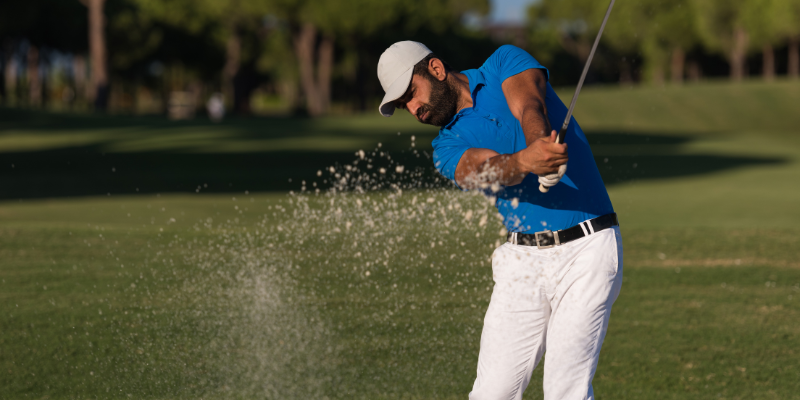Though golf might seem slow-paced to some, it’s actually a highly competitive sport that requires a lot of skill. One way to measure this skill is by determining if someone is a ‘scratch golfer.’ If you’re asking – what is a scratch golfer, you’re in the right place.
In this guide, we’ll explain what a scratch golfer is, where the term comes from, how long it might take to become one, and the differences between scratch golfers and professional players.
Let’s get started and learn all about scratch golfers.
What is Scratch in Golf?
What is scratch in golf? In golf commonly refers to someone with a handicap of 0 or lower. For those unfamiliar with handicaps, a scratch golfer consistently shoots par or better on a standard course.
Among golfers discussing handicaps, they might simply say someone is “scratch” to indicate their handicap is 0.

For instance, if asked about Tom’s handicap, one might respond, “He’s scratch.” This shorthand indicates Tom’s handicap is at the level where he typically plays par golf or better. Also, you can read more about plus handicap.
Definition of a “Scratch Golfer” Provided by the USGA and Others
According to the USGA and other governing bodies, a “scratch golfer” is defined as a player capable of achieving a Course Handicap of zero on any rated golf course.
For rating purposes, male scratch golfers typically drive tee shots an average of 250 yards and can reach a 470-yard hole in two shots at sea level.
Female scratch golfers, on the other hand, typically hit tee shots an average of 210 yards and can reach a 400-yard hole in two shots at sea level.
It’s important to highlight the beginning of the USGA’s definition, emphasizing that a scratch golfer can play to level par. However, in reality, someone with a handicap index of 0 averages around 74-75 for their scoring average throughout the year, provided they play more than just their home course.
While scratch golfers may not consistently perform at the level of professional golfers, they surpass the skill level of nearly 99% of amateur players and possess the ability to shoot par or better on any course.
In the United States, only 1.5% of male golfers maintain a “0” or better handicap index, while the percentage for female players is even lower at 0.5%.
This distinction is reserved for elite players and can be denoted as a “plus ____ handicap.” Achieving a “zero handicap and better” is rare, but for players surpassing scratch level, they transition to a “plus” handicap.
Once in the “plus” category, players must adjust their scores to account for giving strokes back to the course before teeing off, signified by the “+” at the beginning of the handicap.
These players are expected to consistently break par at their home course and adjust their scores accordingly.
The Difference: Pros and Scratch Golfers
- The term “scratch golfer” refers to a golfer who typically shoots even par (or better) on a standard course, meaning their score matches the course’s rating and slope.
- In contrast, a “pro” golfer is someone who plays golf for a living, competing in tournaments and often earning money from sponsorships, endorsements, and prize winnings.
Here are some key differences between pros and scratch golfers:
1. Skill Level
While both scratch golfers and pros are highly skilled players, professional golfers typically operate at a higher skill level. They have honed their game to compete at the highest levels of the sport, often spending countless hours practicing and refining their techniques.
2. Experience
Professionals have usually been playing golf competitively for many years, often starting at a young age. They have extensive experience in tournament play, dealing with pressure situations, and managing their game under various conditions.
3. Training and Coaching
Pros often have access to top-notch training facilities, coaches, and support staff to help them improve their game. They may also receive guidance on fitness, nutrition, mental preparation, and other aspects crucial for peak performance.
4. Competition
While scratch golfers may compete in local tournaments or amateur events, professional golfers regularly compete against some of the best players in the world on tours such as the PGA Tour, European Tour, LPGA Tour, etc.
The level of competition and the stakes involved are typically much higher for professionals.
6. Income and Sponsorships
Professional golfers earn their livelihood through golf, receiving income from tournament winnings, sponsorships, appearance fees, endorsements, and other sources. In contrast, scratch golfers may have other careers or sources of income outside of golf.
7. Commitment
Becoming a successful professional golfer requires immense dedication, sacrifice, and perseverance. Many pros devote their entire lives to the sport, often traveling extensively and spending long hours on the practice range or course.
8. Pressure
While scratch golfers may experience pressure in competition, professionals face heightened pressure due to the expectations of fans, sponsors, media scrutiny, and the financial implications of their performance. Learning to handle pressure and perform under stress is a crucial skill for professional golfers.

How Long Does It Take To Become a Scratch Golfer?
The duration to reach a scratch golfer level differs greatly due to various elements, such as inborn skill, commitment to training regularly, availability of good coaching, physical condition, mindset strategy and the initial golfing abilities.
For some exceptionally talented individuals who start at a young age and have access to top-notch coaching and facilities, achieving scratch golfer status might be possible within a few years.
However, for most people, it typically takes many years of consistent practice and improvement to reach that level.
Here are some general factors that can influence the time it takes to become a scratch golfer:
- Starting Skill Level
If you have prior experience playing golf or have developed skills in related sports, such as athletics or other precision sports, you may progress more quickly than someone starting from scratch.
- Practice Regimen
Consistent and focused practice is crucial for improvement in golf. Spending regular time on the driving range, working on all aspects of the game (drives, approach shots, chipping, putting, etc.), and playing rounds on the course can accelerate progress.
- Quality Instruction
Working with a knowledgeable golf instructor who can provide feedback, guidance, and drills tailored to your individual needs can help you improve more efficiently than trying to learn on your own.
- Physical Fitness
Golf requires a combination of skill, coordination, flexibility, and strength. Engaging in a fitness routine that enhances your physical abilities can contribute to better performance on the course.
- Mental Game
Developing a strong mental approach to golf, including course management, decision-making, focus, resilience, and managing pressure, is essential for reaching scratch golfer status.
- Experience in Competition
Competing in tournaments or other competitive formats can help you gain valuable experience, learn to manage nerves, and identify areas for improvement.
How Many Scratch Golfers are There?
According to the USGA, 1.6 percent of male golfers have a USGA Handicap Index of zero or better. Among female golfers, the percentage is even smaller: 0.37 percent. So the percentage of golfers who are scratches is very, very small.
What about among golfers who don’t have official handicap indexes?
There is no way to know for sure, but we can say this: The percentage is even lower. After all, if you really are that good, don’t you want everyone to know it? (Something else we can say with certainty about disabled recreational golfers: Far fewer are scratch golfers than they claim to be).
Conclusion
In conclusion, a scratch golfer is someone with exceptional skill, capable of consistently shooting par or better on a standard golf course.
Achieving scratch status requires dedication to practice, access to quality instruction, and often many years of effort.
With only a small percentage of golfers reaching this level, being a scratch golfer signifies a high level of proficiency in the game.
F.A.Q
What is a scratch golfer❓
A scratch golfer stands out for their exceptional skill, consistently shooting par or better, unlike other players who may have higher handicaps and typically shoot above par.
How long does it take to become a scratch golfer❓
The time to become a scratch golfer varies, depending on factors such as natural talent, dedication to practice, access to coaching, and starting skill level. While some may achieve it in a few years, for most, it takes many years of consistent effort.
What's the difference between scratch golf and a low handicap❓
Answer: A scratch golfer has a handicap of zero, while a low handicap golfer typically has a handicap between 1 and 5.
What is the difference between a scratch golfer and other players❓
A scratch golfer stands out for their exceptional skill, consistently shooting par or better, unlike other players who may have higher handicaps and typically shoot above par.
What does a scratch golfer mean❓
A scratch golfer is a term used in golf to describe a player who has a handicap index of zero; they typically shoot par or better on most courses.